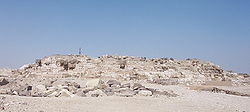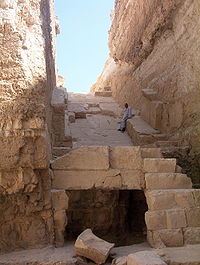
Abu Rawash
Encyclopedia


Egypt
Egypt , officially the Arab Republic of Egypt, Arabic: , is a country mainly in North Africa, with the Sinai Peninsula forming a land bridge in Southwest Asia. Egypt is thus a transcontinental country, and a major power in Africa, the Mediterranean Basin, the Middle East and the Muslim world...
's most northerly pyramid
Pyramid
A pyramid is a structure whose outer surfaces are triangular and converge at a single point. The base of a pyramid can be trilateral, quadrilateral, or any polygon shape, meaning that a pyramid has at least three triangular surfaces...
, Also known as the lost pyramid — the mostly ruined Pyramid of Djedefre
Pyramid of Djedefre
The Pyramid of Djedefre consists today mostly of ruins located at Abu Rawash in Egypt. It is Egypt's most northerly pyramid, and is believed to be built by Djedefre, son and successor to king Khufu...
, the son and successor of Khufu
Khufu
Khufu , also known as Cheops or, in Manetho, Suphis , was a Pharaoh of Ancient Egypt's Old Kingdom. He reigned from around 2589 to 2566 BC. Khufu was the second pharaoh of the Fourth Dynasty. He is generally accepted as being the builder of the Great Pyramid of Giza, one of the Seven Wonders of...
. Originally, it was thought that this pyramid had never been completed, but the current archaelogicical consensus is that not only was it completed, but that it was built about the same size as the Pyramid of Menkaure – the third largest of the Giza pyramids.
Detail
Its location adjacent to a major crossroads made it an easy source of stone. Quarrying — which began in Roman times — has left little apart from a few courses of stone superimposed upon the natural hillock that formed part of the pyramid's core. A small adjacent satellite pyramid is in a better state of preservation.Geology of Abu Rawash: The sedimentary succession in Abu Rawash area ranges in age from Late Cretaceous to Quaternary but is punctuated by several unconformity surfaces. Turonian
Turonian
The Turonian is, in the ICS' geologic timescale, the second age in the Late Cretaceous epoch, or a stage in the Upper Cretaceous series. It spans the time between 93.5 ± 0.8 Ma and 89.3 ± 1 Ma...
to Coniacian
Coniacian
The Coniacian is an age or stage in the geologic timescale. It is a subdivision of the Late Cretaceous epoch or Upper Cretaceous series and spans the time between 89.3 ± 1 Ma and 85.8 ± 0.7 Ma...
representing the sedimentary succession of Abu Rawash Formation
Formation
Formation may refer to:* Formation flying, aerobatics performed with several aircraft* Formation , a high-level military organization* Tactical formation, the physical deployment of military forces-Sports:...
that differentiated into six informal units (members) from younger to older as follows:
- Basal clastic member
- Rudist-bearing limestone-marl member
- Limestone member
- Actaeonella-bearing limestone-marl member
- Flint-bearing chalky limestone member
- Plicatula-bearing marl-limestone member.
Sedimentary depositional environment
Sedimentary depositional environment
In geology, sedimentary depositional environment describes the combination of physical, chemical and biological processes associated with the deposition of a particular type of sediment and, therefore, the rock types that will be formed after lithification, if the sediment is preserved in the rock...
of Abu Rawash Formation are characterized by variable conditions and settings ranging from lower mixed to upper intertidal flat and subtidal channel for the clastic facies and calm to agitated open marine inner to middle platform for the carbonate facies
Facies
In geology, facies are a body of rock with specified characteristics. Ideally, a facies is a distinctive rock unit that forms under certain conditions of sedimentation, reflecting a particular process or environment....
.
Vertical sequence or facies hierarchy display that the facies sequence of the basal clastic member indicates a progradational preitidal sequence. While those of the rudist-bearing member and limestone member represent a cyclic progradtion of high energetic/storm facies above an open marine low energetic fore shoal subtidal facies. The facies sequence of the Acteonella-bearing member reflects two facies associations comprising open marine subtidal assemblage and shoal or bank facies. The latter facies represents the bank that the robust thick shelled Durania arnaudi with the coralline sponge heads accreted local mounds in restricted areas (El-Hassana dome). The vertical facies hierarchy of the flint-bearing chalky limestone member suggests a renewed shoaling of the depositional accommodation, shifting to inner-platform setting and a progradation of mobile bioclastic shoals or banks. The stacking of the sedimentary facies in the Plicatula-bearing member indicates an accumulation in an open shallow sea (inner platform) with intermittent supply of fine terrigenous clastics and clays. (Hanan.S.M. Badawy, Geology Dept., Faculty of Science, Beni Suef
Beni Suef
- Overview :Beni Suef is an important agricultural center, which grew from a small village at the turn of the century and now hosts a population of over 200,000. It was famous for its linen manufacturing in the Middle Ages, and continues to be heavily involved in cotton-spinning and carpet-making....
, Egypt
Egypt
Egypt , officially the Arab Republic of Egypt, Arabic: , is a country mainly in North Africa, with the Sinai Peninsula forming a land bridge in Southwest Asia. Egypt is thus a transcontinental country, and a major power in Africa, the Mediterranean Basin, the Middle East and the Muslim world...
)

